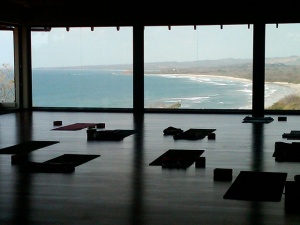Wow- we’ve been having such gorgeous weather!
It’s great weather for getting in some outdoor workouts. If you usually workout indoors, it can be really motivating to change things up a bit by taking your sessions out into the fresh air.
Speaking of changing things up, I’ve decided to refocus a bit this week and give my muscles a break by doing some longer stretching sessions. I’ve been focusing on fairly heavy strength work lately (about 4 sets of 8 reps per exercise) and I’m craving some extra stretching time to keep my muscles from being too tense. This means I’ll shorten my lifting time a bit and lengthen the time I use at the end of my session to do some developmental stretching, and also adding in a couple of gentle hour-long yoga classes.
I did a yoga class this morning. I wish that’s where my studio was! Nonetheless, the class was great and it felt absolutely glorious. I always feel like the Gumby after a good yoga class- in a good way!
I thought it would be a good excuse to do a post on basic stretching principals and info.
The benefits of stretching
Any good exercise programme should include a mix of cardio, resistance and flexibility training. This trio of activities is key to a complete training programme- the balance will really depend on your current fitness level and your training goals. Despite the importance of all three of these activities, flexibility is often completely overlooked in people’s programmes. Even when it is included in a programme, you so often see people skipping stretching after a good workout to get on with the rest of their day. It’s understandable, but this really doesn’t do you any favours. The benefits of stretching are significant. Stretching increases your range of motion, improves coordination and makes muscle contractions smoother, thus making your workouts more effective. It reduces muscle soreness and tension, improves circulation and used appropriately can significantly improve posture and reduce chances of injury.
The many types of flexibility training
There are loads of different types of stretching, and each type has an appropriate application, whether it’s before or after a workout, to assist injury recovery, or to correct certain postural muscle imbalances. You can use active or passive stretching, static or dynamic, maintenance or developmental, ballistic, isometric and more. Used appropriately, stretching is an extremely effective training aid. But applying the wrong type of stretching can also really hinder your training, or even cause injuries.
I’m going to write today about the basic types of stretching you should use before a workout, assuming you’re an average healthy uninjured person. I’ll write a post next week about post-workout stretching.
Pre-workout: Dynamic stretching
The recommendations for stretching have moved along significantly over the past few decades, and scientific studies are guiding updated stretching recommendations. Gone are the days when trainers recommended static stretching (holding longs stretches) before a session. Evidence is showing that static stretching turns off muscle receptors, and makes your muscles less responsive, thus making your subsequent workout less effective. Static stretching should only be used before a session where muscles are overworking, to correct imbalances.
Evidence now shows that dynamic stretching should be applied before a session to waken your muscles and get them responding quickly, and to loosen up muscles and increase your range of motion in preparation for a workout. Applying dynamic stretching will decrease your risk of injury since your muscles will be prepared for exercise, and increases the effectiveness of your training since you’ll be fully warmed up and reactive to the movements.
So, how do you actually do it?! Dynamic stretches are large, smooth, controlled movements such as leg swings, arm swings, unweighted lunges or squats. The movements you use should mimic the movements of your upcoming exercise session.
| Here’s how to apply dynamic stretches pre-workout: 1. Start off with some joint circles to get your joints loosened up and lubricated.2. Do 4-5 minutes of cardio of your choice to slowly and gently raise your heart rate and warm up your body.3. Start dynamic stretches, using movements that mimic the exercises you’ll be doing in your workout. Complete around 10 repetitions of the movement, gradually increasing your range of motion each time, as your body warms up.
If you’re doing an upper body routine, with pushups, chest presses, rows and flyes, then your dynamic stretches should involve controlled swinging of your arms forwards and backwards, up ad down, in similar movements, increasing your range of motion on each repetition. If you’re doing a lower body workout with squats, lunges and deadlifts, then your dynamic warmup should involve similar movements, without weights. Again, slowly increase your range of motion on each repetition. Use a similar warmup for cardio, mimicking the exercise you’ll be performing at speed in your workout. If you’re running, do some knee raises and leg swings. If you’re canoeing, do some arm circles and swings. Here are some example videos on you tube. Great demonstration of upper and lower body dynamic stretches |
You should really notice a difference when you go into a session after completing a dynamic warm-up. You’ll be able to lift heavier sooner, and your muscles will be much more reactive and ready to work!
Stay tuned for Stretching Part 2 next week where I’ll post about post-workout stretching.
Until next time!
Melissa






[…] Part 1 last week on pre-workout stretching, this post looks at post-workout stretching. Again, this routine […]
[…] been doing most of my big posts on Sundays and I’ll continue to do this. The Sunday posts are more in-depth and informative […]
[…] You simply won’t achieve the same level of health or fitness without including resistance training in your programme. This applies to you no matter your age, fitness capacity or gender. Remember, a good fitness programme involves a healthy balance of cardio, resistance and flexibility (see stretching posts here and here). […]
[…] stiffness and soreness in the next couple of days. For more on this topic, check out my posts on dynamic warm-ups and […]
[…] any interval training be sure to start with a dynamic warm up and end with a cool down stretch. The warm up is key so that your body is ready and able to work at […]
[…] build up to the main event while doing actions similar to your exercise. Check out my posts on warm up and cool down stretch […]